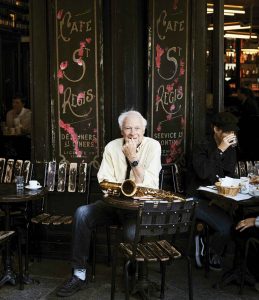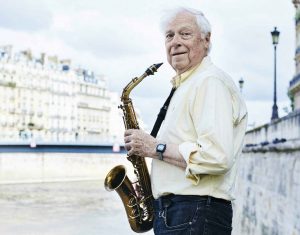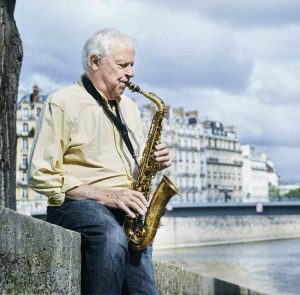 Photos By Antoine Doyen
Photos By Antoine Doyen
It was 2007. He was pushing 70. He and his wife had separated, and he was about to retire. Pages in his life were turning. It was time, he decided, to flip ahead to the next chapter.
Now, 11 years later, Charlie Crummer ’59, a one-time physicist in Southern California, lives in an apartment on the Île Saint-Louis, a quiet, mostly residential plot of land in the River Seine as it flows through the heart of Paris. He’s an inch or two over six feet tall, his white hair mildly scattered, as Einstein taught us a physicist’s hair ought to be. On the street, he winds a scarf around his neck, which isn’t actually a municipal fashion ordinance in Paris but might as well be. Inside a quiet, simple neighborhood crêperie, he relaxes over lunch as he talks about how the seeds of his move from California to France had pretty much been sown long before he shipped out. About how, really, it all started with a car.
But not just any car.
“It was a 1966 Citroën DS,” he says, smiling at the recollection. “Do you know it? A French classic. I’d been driving an old Chrysler—a real tank. I brought it to the repair shop and the owner had this ’66 DS, a Pallas, which was the luxury model. He said ‘Take it for the weekend and try it out.’ Fifty miles later I was a raving convert. This was 1972. Riverside, California.”
For car guys back then, the front-wheel-drive Citroën DS was a dream vehicle, with self-leveling hydropneumatic suspension, power steering, disc brakes and other features that were, for the time, trophies of cutting-edge engineering and an oddly attractive space-age body design. A decade ago, a poll of 20 top automotive designers named the introductory version of the iconic vehicle—the 1955 model—“The Most Beautiful Car of All Time.”
“I kept that car for 13 glorious years,” Crummer continues, “until one day it ran out of water and the engine was damaged. We were going on vacation and drove it as far as Sacramento airport and it died. I left it in the airport parking lot for quite a while and then sold it to a Citroën aficionado. It was approaching 200,000 miles; all it needed was an engine overhaul. I dream that somewhere it’s still on the road. It was a work of engineering art.”
“Really,” he says, “it was because of the Citroën that I fell in love with France. I knew it in 1977, when we took a family trip to France—we were there just a week, less than a day in Paris. That was my first time in the country, but when we left… I can’t explain it, but I felt kind of homesick. It was like leaving my hometown.”
He especially connected with Paris—the soaring churches, the endless art, the streets and squares—but he didn’t go back for more than a quarter-century. When he did return at last, for a short stay in 2004, he found the city’s appeal was still there. He visited again the next year, and the next. It was after his separation in 2006 that he began to think seriously about moving there. Moving—you might say—to his spiritual hometown.
The following March 28, Crummer retired from his job as a physics lab manager at UC Santa Cruz. That same day, he was on a plane to Paris.
He brought along his two big lifelong passions: physics and jazz. (Ask him to name his major influences and he’ll start with Albert Einstein and Charlie Parker.) Both interests go back to his time at Pomona. A physics major (he later earned a Ph.D. in quantum gauge theory at UC Riverside), he was a versatile reed musician who played oboe in the orchestra as well as jazz on several members of the saxophone family. “I remember playing Dixieland on an exquisite gold-plated Selmer soprano sax owned by a professor in the music department,” he recalls. “That was ‘Doc’ Blanchard. To this day, I’m amazed he let me borrow such a valuable horn.”
It being the 21st century, among the first things Crummer did in his new Paris home was to establish a blog, so he could express an occasional thought about his new surroundings and a stray opinion about the world as he sees it. He headed his page:
Charlie
in
France
Some thoughts and some pictures
Impressions of Paris and other random thoughts
 In his first blog post 11 summers ago, he celebrated the city’s parks and alleys and gardens. He responded emotionally to the sound of the great 19th-century organs in the churches of Saint-Sulpice and La Madeleine (“Tears of joy well in my eyes, taking me by surprise. My heart swells in my throat and explodes with the passion of the moment”). He reported briefly on visits to two jazz clubs. In one, a tiny bar (“about 4m by 8m, good beer, not so good sandwiches”), the audience barely outnumbered the performers: There were, in total, three listeners, including Crummer; the band was a tenor sax player and a pianist (“I listen to the sound of six hands clapping as they finish each tune”).
In his first blog post 11 summers ago, he celebrated the city’s parks and alleys and gardens. He responded emotionally to the sound of the great 19th-century organs in the churches of Saint-Sulpice and La Madeleine (“Tears of joy well in my eyes, taking me by surprise. My heart swells in my throat and explodes with the passion of the moment”). He reported briefly on visits to two jazz clubs. In one, a tiny bar (“about 4m by 8m, good beer, not so good sandwiches”), the audience barely outnumbered the performers: There were, in total, three listeners, including Crummer; the band was a tenor sax player and a pianist (“I listen to the sound of six hands clapping as they finish each tune”).
And then: “I took my clarinet down to the Seine the other evening. I found a place where I could sit alone. Carefully, I put the horn together and then paused. Who am I? An old guy sitting in rapture beside the ancient river ‘flowing under’ that has lived its life continuously since before the first man came there to receive its succor. I’m a little nervous even though there is no one else around. I can’t remember any tunes so I just play some changes. The river is kind. It flows on.”
Crummer brought his clarinet and his alto sax to Paris; he left two other horns—a tenor and a baritone sax—behind. “A bari is too big,” he explains. “You can only take so much on a plane.” In a life reboot, wherever you go to, you take some of you along, you leave some of you behind.
To keep up his musical chops, Crummer downloaded a copy of the famous Universal Method of Saxophone, the sax man’s bible (“I had it as a kid”) for exercises. He started playing in a saxophone quartet. “The leader of our group is a tenor man who’s an economist,” he says. “He travels a lot, so we can’t rehearse regularly. We have a guy who doubles on soprano and alto, and I’m on second alto. The other two are the leader on tenor and another guy on bari. We play mostly jazz and tango. We have a terrific jazz chart by Gerry Mulligan, better than anything else I’ve seen from him. We also have great charts from Astor Piazzolla, the ‘nuevo tango’ composer.”
Not that joining a group means the end of his solo playing. “I look forward to the good weather,” he adds, “when I can walk down by the old coal ramp by the Seine and play, alone, next to the swans and ducks. It’s so romantic.”
His occasional blog entries, usually brief, are written at home or, on occasion, sitting on a bench in a park with a laptop and free wi-fi. He mentions musical events ranging from a solo balalaika concert to a quartet playing gypsy jazz in a church. He marvels at Paris architecture. He offers quick opinions on capitalism versus socialism (the way economist Milton Friedman uses them, they’re cartoon-like loaded terms, he argues, and “Life isn’t a cartoon strip”), on oil drilling and oil spilling (“It’s time to just leave things alone down in the deep ocean”), on gun deaths and the NRA (he’s very opposed), and on his kids (he’s very proud).
Lately, Crummer has also been guest blogging for a small not-for-profit publisher in San Francisco, which has appointed him its “Paris Bureau Chief.” Since he finds managing the French language an ongoing battle, he schedules weekly one-on-one sessions with a French woman in which they converse for an hour in French and an hour in English. He’s a retiree apparently with no shortage of ways to keep occupied.
The physics part of his life came along to Paris mainly in the form of a paper that has been, typically for the scientific world, years in the making: “Aerodynamics at the Particle Level,” a continuation of work he began back in Santa Cruz. The paper—90-some pages long—explores the collision of fluids with solid surfaces from the particle perspective. It has been posted online for comments and suggestions from the scientific community; he’s revised it multiple times. “The way aeronautical engineers design a wing,” Crummer explains, “is to look at a bird and make a model and put it in a wind tunnel. We actually know a fair amount about just why things happen as they happen, although not enough. But engineers don’t care; they just want to make something that works. I want to know what’s behind the phenomenon.”
Considering all the elements of his Paris life, could he return to the States? That may depend on someone who entered his life soon after he arrived in Paris: Christine.
 During his first month in the city, at the coffee hour after a regular service at the interdenominational American Church in Paris, he noticed a woman across the room. “She looked like a damsel in distress,” he recalls. “I thought ‘Uh-oh, that’s trouble’ but I went over and introduced myself. This is a church for Americans mostly, but she was French. She had an apartment to rent on the Île Saint-Louis, and she was there to post a notice on the church bulletin board.”
During his first month in the city, at the coffee hour after a regular service at the interdenominational American Church in Paris, he noticed a woman across the room. “She looked like a damsel in distress,” he recalls. “I thought ‘Uh-oh, that’s trouble’ but I went over and introduced myself. This is a church for Americans mostly, but she was French. She had an apartment to rent on the Île Saint-Louis, and she was there to post a notice on the church bulletin board.”
The woman was Christine, and as it turned out, she wasn’t trouble at all.
At the time, Crummer had a six-month rental arrangement across town, so he didn’t need the apartment Christine was looking to rent out, but when the six months ran out they moved together to her childhood home in a close suburb, where she was able to care for her aging mother. “If I hadn’t been religious when I came,” Crummer says, “I would have been converted just because of the magical things that have happened to me since I moved here.”
Eventually, they took over the apartment she had been looking to rent that day, the apartment on the Île Saint-Louis. The island is just a few hundred yards from the tourist hordes around Notre-Dame Cathedral yet light-years away on the serenity scale. “I’ve been all over the city by now,” Crummer says. “The Île Saint-Louis is the absolute best location I can imagine.
“Christine would love to live in San Francisco—she’s thought about that for a long time. I might go back there with her. After all, she has a dream; she helped me realize mine, so what could be fairer? We might do six months and six months. There’s a lot to be worked out.”
He pauses a few seconds to reflect, then continues: “I’m thinking of the old saying: ‘Go with the flow.’ It’s all an adventure. We’ll see what happens.”
